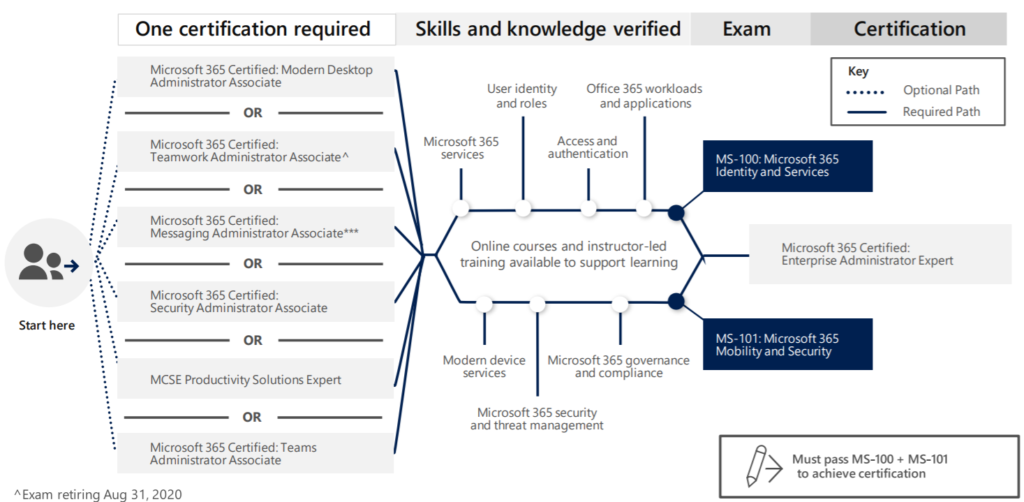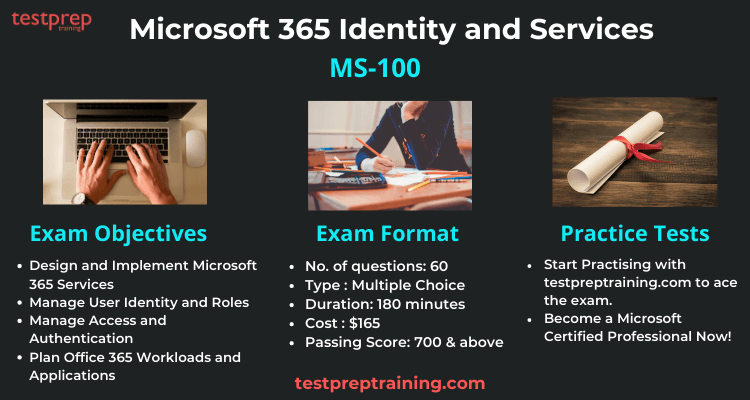The need for professionals holding Microsoft Certifications has surged significantly in recent years. Do you want to Set yourself aside from the competition by earning this globally recognized credential ? Then the Microsoft MS-100 Microsoft 365 Identity and Services exam is just the right certification for you. It validates your technical skills and expertise. However, earning an MS-100 certification is not an easy feat. In other words, it is quite difficult for candidates to prepare for the certification exam and pass it in the first attempt.
You need the right study strategy to ace the exam. Moreover, it is very important that you must have clarity about the exam details and policies before beginning your preparation journey. This helps you devise a study plan that aligns with the exam objectives. Therefore, we provide you a detailed article about the exam format that is easy to digest and helps you prepare better. . Furthermore, we will be adding a few quick links to the learning resources that will supplement your preparations. So without further ado lets begin
What is MS-100 Exam?
Microsoft 365 Identity and Services (MS-100) exam assesses you in the role of Microsoft 365 Enterprise Administrators with abilities to evaluate, plan, migrate, deploy, and manage Microsoft 365 services.
Yet, these administrators have the duty of handling multiple Microsoft 365 tenant management tasks for a business. This includes managing identities, security, compliance, and supporting technologies.
Exam Knowledge Requirement
- Firstly, you must have a working knowledge of Microsoft 365 workloads.
- Secondly, you must have been an administrator for at least one Microsoft 365 workload (Exchange, SharePoint, Skype for Business, or Windows as a Service).
- Lastly, a working knowledge of networking, server administration, and IT fundamentals such as DNS, Active Directory, and PowerShell.
Microsoft MS-100 | Learning Pathway
Microsoft MS-100 Certifification Path:

Microsoft MS-100 Exam Format
The exam format acts as a blueprint for the exam. It helps you get an overview of the what the actual exam will look like. Lets have a quick glance t the exam format to enhance your preparations:
- Firstly, this exam covers 40 to 60 questions. You will get 180 minutes to complete the exam. Therefore, you need to maintain a great speed with high accuracy to complete the exam.
- Secondly, the Microsoft MS-100 exam questions can be of type scenario-based single answer questions, multiple-choice questions, arrange in the correct sequence type questions, drag & drop questions, mark review, drag, and drop, etc. As you answer the questions, use the method of elimination. Figure out and eliminate the wrong choice, and voila! you have the right answer.
- Moreover, to apply for the exam, the examination fee is $165 USD including taxes.
- Also, the exam is available in English and the Japanese language.
- Finally, to score a minimum of 700 or more to pass the exam
Exam Scheduling
Microsoft MS-100 exam measures the ability to perform technical tasks for designing and implementing Microsoft 365 services with managing access and authentication. Candidates also plan Office workloads and applications.
You can schedule the exam in the following ways:
- For Non-Students interested in Technology

- For Students or Instructors

Exam Policy
You can cancel your Microsoft Exam for free up to 24 hours before your scheduled time. However, if you miss the exam without rescheduling or canceling, Microsoft has the right to forfeit your entire exam fee. To make changes, you can reschedule or cancel through the Certification Dashboard.
Certification Validity
Microsoft Certifications don’t have an expiration date anymore. In the past, they used to be valid for three years, with some needing recertification after two years. Microsoft has changed this process, and now the certifications stay valid for a lifetime.
Microsoft MS-100 Exam Outline
Understanding the course outline of Microsoft MS-100 exam is the next important step. It familiarises you with the exam framework. The exam course includes 4 domains. The Percentage against each domain represents its weightage in the exam. Also, these domains are divided in to subtopics to provide further insights about the exam course. You should tailor your study plan around these exam topics to achieve the certification.
The course Outline for the Microsoft MS-100 exam was updated on February 3, 2023
1. Deploy and manage a Microsoft 365 tenant (15—20%)
Plan and implement a Microsoft 365 tenant
- plan a tenant (Microsoft Documentation: Plan your tenant in Microsoft 365)
- create a tenant (Microsoft Documentation: Set up your Microsoft 365 tenant)
- implement and manage domains (Microsoft Documentation: Add a domain to Microsoft 365)
- configure organizational settings, including security, privacy, and profile (Microsoft Documentation: Use policy settings to manage privacy controls)
Monitor Microsoft 365 tenant health
- create and manage service requests (Microsoft Documentation: Manage service requests in Service Manager)
- create an incident response plan (Microsoft Documentation: Incident response planning)
- monitor service health check (Microsoft Documentation: Microsoft 365 service health)
- monitor application access (Microsoft Documentation: Microsoft 365 Apps monitoring)
- configure and review reports, including Azure Monitor logs and Log Analytics workspaces (Microsoft Documentation: Create a Log Analytics workspace)
- schedule and review usage metrics, including Microsoft Viva Insights and Adoption Score
2. Plan and manage user identity and roles (30—35%)
Plan identity synchronization
- design synchronization solutions for multitenant and multi-forest scenarios (Microsoft Documentation: Topologies for Azure AD Connect)
- evaluate whether objects should be synchronized, not synchronized, or created as cloud-only (Microsoft Documentation: One or more objects don’t sync, End-to-end troubleshooting of Azure AD)
- identify which Azure AD Connect features to enable, such as writeback and device synchronization (Microsoft Documentation: Custom installation of Azure Active Directory Connect)
- identify synchronization pre-requisites, including connectivity method, permissions, and server requirements (Microsoft Documentation: Set up directory synchronization for Microsoft 365)
- choose between Azure AD Connect and Azure AD Connect cloud sync
- plan user sign-in for Azure AD hybrid identities, including pass-through authentication, seamless, and SSO (Microsoft Documentation: Choose the right authentication method, Azure Active Directory Seamless Single Sign-On)
Implement and manage identity synchronization with Azure AD
- prepare for identity synchronization by using IdFix (Microsoft Documentation: Prepare for identity synchronization to Microsoft 365)
- configure and manage directory synchronization by using Azure AD Connect cloud sync (Microsoft Documentation: Create a new configuration for Azure AD)
- configure and manage directory synchronization by using Azure AD Connect
- configure Azure AD Connect object filters (Microsoft Documentation: Azure AD Connect sync: Configure filtering)
- monitor synchronization by using Azure AD Connect Health (Microsoft Documentation: Azure AD Connect)
- troubleshoot Azure AD Connect synchronization (Microsoft Documentation: Understanding errors during Azure AD synchronization)
Plan and manage Azure AD identities
- plan Azure AD identities (Microsoft Documentation: Determine your cloud identity model)
- create and manage users (Microsoft Documentation: Microsoft 365 user accounts)
- create and manage guest users (Microsoft Documentation: Manage groups guest access)
- create and manage groups, including Microsoft 365 groups (Microsoft Documentation: Manage who can create Microsoft 365 Groups)
- manage and monitor Microsoft 365 license allocations (Microsoft Documentation: View Microsoft 365 licenses and services with PowerShell)
- perform bulk user management, including PowerShell (Microsoft Documentation: Create Microsoft 365 user accounts with PowerShell)
Plan and manage roles in Microsoft 365
- plan for role assignments (Microsoft Documentation: Roles for Microsoft 365 services in Azure Active Directory)
- manage roles in Microsoft 365 admin center (Microsoft Documentation: admin roles in the Microsoft 365 admin center)
- manage administrative units (Microsoft Documentation: Administrative units in Azure Active Directory)
- plan and implement privileged identity management for Azure AD roles (Microsoft Documentation: Azure AD Privileged Identity Management)
3. Manage access and authentication (20—25%)
Plan and implement authentication
- choose an authentication method, including Windows Hello for Business, passwordless, and tokens (Microsoft Documentation: Passwordless authentication options for Azure Active Directory)
- implement and manage authentication methods (Microsoft Documentation: authentication and verification methods)
- implement and manage self-service password reset (SSPR) (Microsoft Documentation: Azure AD SSPR)
- implement and manage Azure AD password protection (Microsoft Documentation: Azure AD Password Protection for Active Directory Domain Services)
- configure and manage multi-factor authentication (MFA) (Microsoft Documentation: Set up multifactor authentication for Microsoft 365)
- investigate and resolve authentication issues (Microsoft Documentation: Troubleshoot Azure Multi-Factor Authentication issues)
Plan and implement secure access
- plan and implement access reviews in Azure AD identity governance (Microsoft Documentation: Azure AD access reviews)
- plan and implement entitlement packages in Azure AD identity governance (Microsoft Documentation: Azure AD entitlement management)
- plan for identity protection (Microsoft Documentation: Identity Protection)
- implement and manage Azure AD Identity Protection (Microsoft Documentation: Manage Azure AD Identity Protection)
- plan conditional access policies (Microsoft Documentation: Conditional Access)
- implement and manage conditional access policies
Plan and implement application access
- plan access and authentication to application registrations and Azure AD enterprise applications (Microsoft Documentation: applications application management in Azure Active Directory)
- configure application registration in Azure AD (Microsoft Documentation: Register an app with Azure Active Directory)
- manage user permissions for application registrations (Microsoft Documentation: Azure AD built-in roles)
- manage OAuth application requests in Azure AD, Microsoft Defender for Cloud Apps, and Microsoft 365 Defender (Microsoft Documentation: OAuth app policies)
- configure Azure AD Application Proxy (Microsoft Documentation: Using Azure AD Application Proxy)
- publish enterprise applications in Azure AD (Microsoft Documentation: Submit a request to publish your application)
4. Plan Microsoft 365 workloads and applications (20—25%)
Plan and implement Microsoft 365 Apps deployment
- plan for client connectivity to Microsoft 365 workloads (Microsoft Documentation: Microsoft 365 network connectivity principles)
- plan Microsoft 365 App compatibility by using the Readiness Toolkit (Microsoft Documentation: Use the Readiness Toolkit to assess application compatibility)
- plan for Microsoft 365 Apps updates (Microsoft Documentation: Overview of the update process for Microsoft 365 Apps)
- specify initial configuration for Microsoft 365 Apps by using the Microsoft 365 Apps admin center (Microsoft Documentation: Set up Microsoft 365 Apps for business)
- implement Microsoft 365 Apps deployment and software downloads (Microsoft Documentation: Overview of the Microsoft 365 Apps admin center)
Plan and implement Exchange Online deployments
- plan for DNS records required by Exchange Online (Microsoft Documentation: External Domain Name System records for Office 365)
- plan and implement an Exchange hybrid organization (Microsoft Documentation: Exchange Server hybrid deployments)
- plan and implement mail routing, including connectors, mail flow rules, and remote domains (Microsoft Documentation: Set up connectors to route mail between Microsoft 365)
- plan and implement organizational settings (Microsoft Documentation: Plan and manage organizational settings with Exchange Online)
Plan and implement Microsoft SharePoint Online, OneDrive, and Microsoft Teams
- specify SharePoint site types, site collections, and lists (Microsoft Documentation: Overview of sites and site collections in SharePoint Server)
- plan a migration strategy for SharePoint Online and OneDrive (Microsoft Documentation: Overview of the SharePoint Migration Tool (SPMT))
- identify hybrid requirements for SharePoint Online (Microsoft Documentation: Hardware and software requirements for SharePoint hybrid)
- manage access configurations for SharePoint Online and Microsoft Teams (Microsoft Documentation: Manage sharing settings)
- manage SharePoint Online tenant and site settings (Microsoft Documentation: SharePoint Online tenant properties)
- map Phone System features to requirements (Microsoft Documentation: Microsoft 365 and Office 365 platform service description)
- plan and implement organizational settings (Microsoft Documentation: Plan and manage organizational settings with Exchange Online)
- plan, implement, and manage guest and external access (Microsoft Documentation: Guest users in Microsoft 365 admin center)
Exam Result
The result is declared immediately after your exam. The score is displayed and you will see whether you have cleared the exam or not. You need to score 700 or above to qualify this exam.
“Effective performance is preceded by painstaking preparation” Therefore, you must prepare with the right resources to pass this exam with flying colours. So lets have a look at your learning resources.
Microsoft MS-100 Exam Preparation Guide

Certification can be a bit stressful in varying ways. But preparing with the right resources will help you sail smoothly in your preparation journey. However, before venturing on any journey, one must have a clear idea of what he/she is putting themselves into. Therefore, you must begin wit the Official Exam site and familiarise with the exam objectives. This will provide you a clear idea about the exam.
Next you should visit the Microsoft learning platform to understand the exam concepts in detail. Further, you can choose training courses. Microsoft provides Instructor-led training that covers central elements of Microsoft 365 enterprise administration. The Microsoft 365 Identity and Services course will help you understand the key components that must be planned for when designing your Microsoft 365 tenant.
Additionally, make use of Microsoft Documentation for learning. Microsoft Docs has modules that provide extensive knowledge about Microsoft 365 and its services. Don’t forget the importance of books, which are golden resources for preparation. They allow you to easily find and learn about specific topics you want to explore. Related to the MS-100 exam, there are some excellent books ruling the market for years that you can use or refer to study. We suggest you to refer the Microsoft Exam MS-100 Study Guide with respect to books.
Lastly, the best way to enhance your knowledge is by referring Online Tutorials. These Tutorials provide in depth understanding about the exam and its concepts. Additionally, it also covers exam details and policies. Therefore learning with Online Tutorials will result in strengthening your preparation.
Experts Corner
In a nutshell, Microsoft MS-100 exam can open the door to increased visibility, better opportunities and new jobs in your industry. It will help you bridge the gap towards your dream job. A strong preparations strategy will go a long way in your journey towards the exam. But once you have covered your complete syllabus for the exam, how will you be able to analyse your preparation for each topic? The answer is simple- with Practice tests. Practice tests are the most efficient as well as beneficial ways to determine the level of your preparation. Furthermore, the primary purpose of creating practice tests is to simulate the actual exam environment for the candidate. Engaging in practice tests allows you to identify your strengths and address your weaknesses. Hence, strive to take as many practice tests as possible to enhance your confidence. Lets Start Practising Now!



